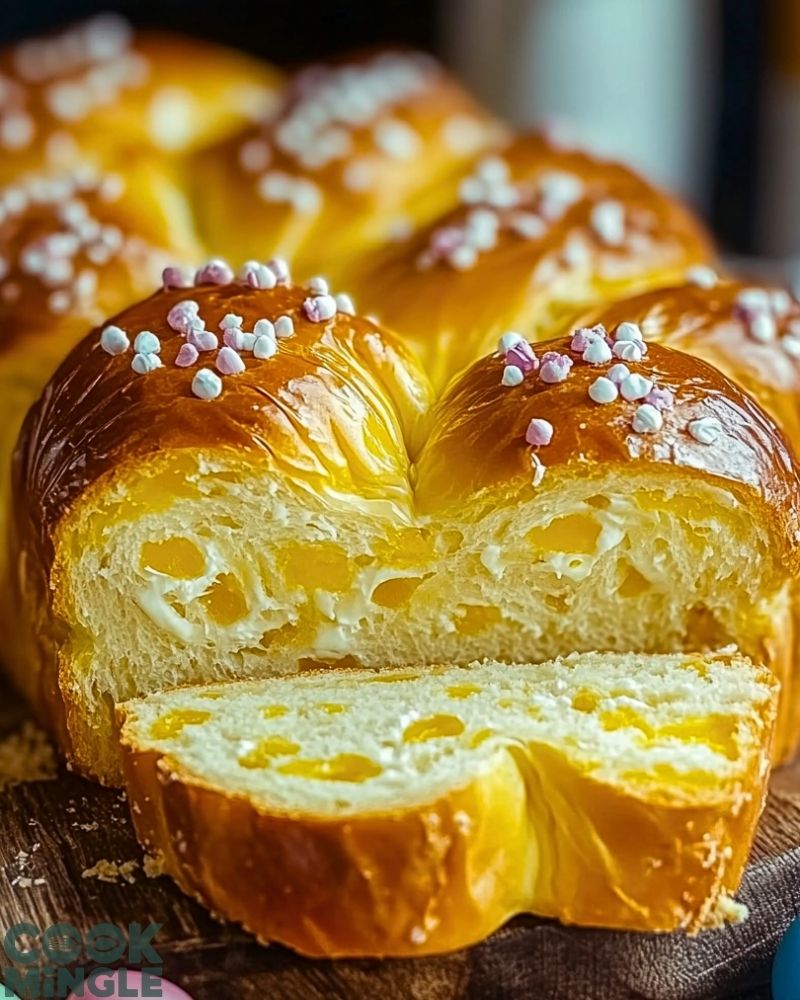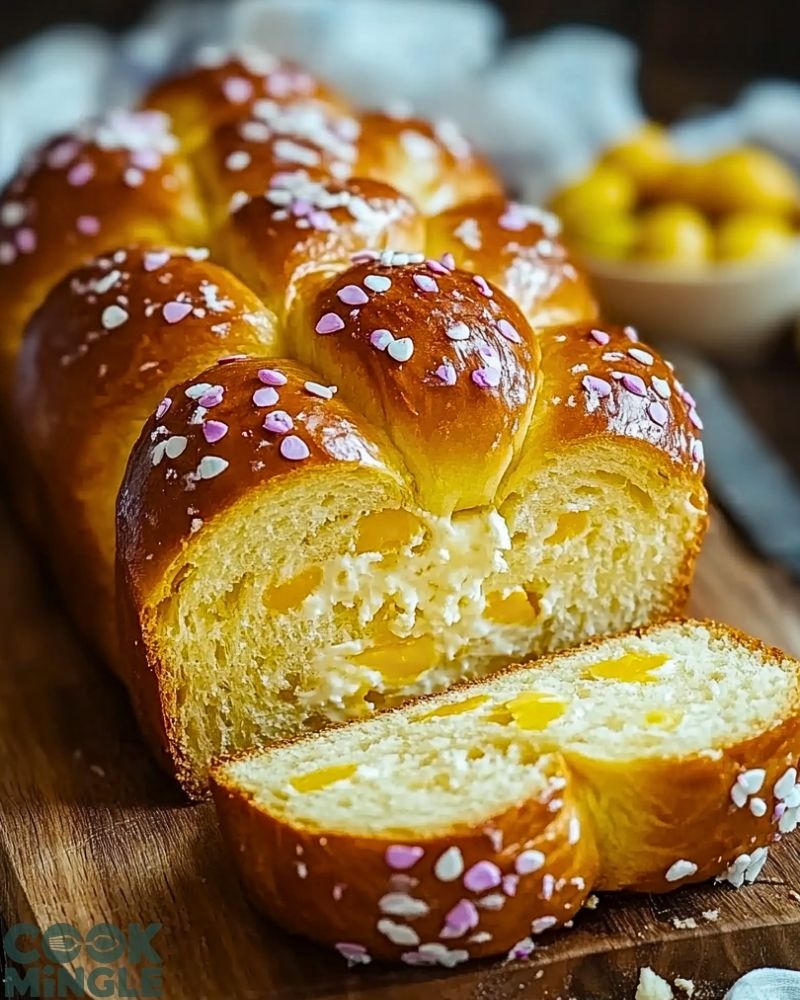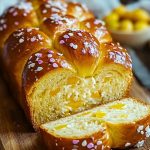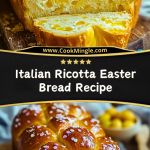I’ve always had a soft spot for traditional Italian baking, and Italian Ricotta Easter Bread is one of those recipes that feels like a warm hug from Nonna’s kitchen. Its pillowy texture, golden crust, and the faintly sweet aroma of fresh ricotta tucked within the braided dough bring so much comfort and nostalgia. Each bite has that tender richness from the cheese, balanced with just a touch of citrus and vanilla, making it a real celebration bread — perfect for Easter mornings, spring brunches, or simply when you want something special.

What I love most is how this bread doesn’t shout for attention — it quietly impresses. Whether enjoyed plain, toasted with a smear of butter, or as part of a festive spread, it never fails to make people ask, “Did you really bake this?” Yes, and you absolutely can too.
Why You’ll Love This Italian Ricotta Easter Bread
This bread isn’t just beautiful to look at — it’s delightfully soft and subtly sweet with the creamy richness of ricotta cheese baked right in. It braids together a feast of textures and flavors: a shiny, golden crust gives way to a moist, tender crumb with whispers of vanilla and citrus. The ricotta keeps it incredibly moist, even for days, and it pairs perfectly with both sweet and savory toppings. Whether you’re baking it for Easter, brunch, or a treat-yourself weekend, this loaf brings a dose of joy and just the right touch of tradition to the table.
What Kind of Ricotta Should I Use?
For the best Italian Ricotta Easter Bread, use full-fat ricotta cheese. It adds creaminess, richness, and moisture to the dough, resulting in that soft, slightly dense but tender texture you want. Avoid ricotta that’s too watery — if your ricotta has excess moisture, let it drain in a fine mesh sieve or cheesecloth for about 30 minutes before using. You can use store-bought ricotta, but if you’ve ever tried homemade ricotta, you’ll know it takes this bread to a whole new level.
Options for Substitutions
You don’t have to stick strictly to the traditional version — this bread is wonderfully flexible.
- Ricotta: If you’re out of ricotta, mascarpone can work in a pinch, although it will make the bread richer and denser.
- Flour: All-purpose flour works great, but bread flour can add a bit more chew if you like a firmer bite.
- Sugar: For a slightly less sweet bread, you can reduce the sugar by 1–2 tablespoons without affecting the dough.
- Flavorings: Instead of just vanilla, try a splash of almond extract or a teaspoon of orange blossom water for something more floral.
- Citrus zest: Lemon is traditional, but orange zest adds a sunny, vibrant twist that complements the ricotta beautifully.
- Sprinkles or sugar: If you don’t have nonpareils or colored sprinkles, simply dust the top with pearl sugar or a light coating of granulated sugar after the egg wash for a sparkling finish.
Ingredients for Italian Ricotta Easter Bread
Each ingredient in this bread serves a purpose — creating the soft, tender, slightly sweet loaf that’s perfect for springtime baking.
- All-Purpose Flour: This forms the structure of the bread. It gives the dough strength while keeping it light enough to rise beautifully.
- Whole Milk Ricotta Cheese: The star ingredient — it brings rich moisture, subtle tang, and a creamy depth to the dough.
- Eggs: Essential for binding and enriching the dough, eggs help give the bread its golden color and tender crumb.
- Granulated Sugar: Adds a gentle sweetness to the loaf and helps activate the yeast slightly for a lovely rise.
- Active Dry Yeast: This is what makes the dough rise and gives the bread its airy texture.
- Butter: Softened butter contributes richness and softness, enhancing both flavor and mouthfeel.
- Milk: Used to hydrate the dough and activate the yeast, warm milk makes the dough softer and more supple.
- Vanilla Extract: Adds a layer of warm, floral sweetness that complements the ricotta beautifully.
- Citrus Zest (Lemon or Orange): Brings brightness and a subtle tangy fragrance to the loaf, elevating its flavor.
- Salt: Balances the sweetness and enhances all the other flavors.
- Egg Wash (egg + a splash of milk): Brushed on top for that golden, glossy finish.
- Colored Sprinkles or Pearl Sugar: Adds a festive touch, perfect for Easter or special occasions.

Step 1: Prepare the Yeast
Warm the milk just slightly — it should feel like a warm bath, not hot. Stir in a teaspoon of sugar and sprinkle the active dry yeast on top. Let it sit for 5–10 minutes until it’s frothy and bubbly. This means your yeast is alive and ready to leaven the dough.
Step 2: Mix the Wet Ingredients
In a large mixing bowl (or the bowl of a stand mixer), beat together the ricotta, eggs, softened butter, vanilla extract, citrus zest, and the rest of the sugar. Mix until smooth and creamy — it doesn’t need to be completely uniform, but the ricotta should be mostly broken down.
Step 3: Combine and Knead
Pour the activated yeast mixture into the ricotta mixture and stir to combine. Gradually add the flour and salt, about 1 cup at a time, mixing until a soft, slightly sticky dough forms. Knead by hand or with a dough hook for 8–10 minutes, until the dough becomes smooth, elastic, and only slightly tacky.
Step 4: First Rise
Place the dough in a lightly greased bowl and cover it with a damp towel or plastic wrap. Let it rise in a warm, draft-free spot for about 1½ to 2 hours, or until doubled in size.
Step 5: Shape the Dough
Punch down the risen dough gently and divide it into 3 equal parts. Roll each into a long rope about 12–14 inches long. Braid the ropes together and tuck the ends under. Place the braid on a parchment-lined baking sheet.
Step 6: Second Rise
Cover the shaped dough loosely and let it rise again for 30–45 minutes. It should puff up slightly but doesn’t need to double.
Step 7: Finish and Bake
Preheat your oven to 350°F (175°C). Brush the top of the braid with egg wash, then sprinkle with colored sprinkles or pearl sugar. Bake for 30–35 minutes, or until the bread is golden brown and sounds hollow when tapped on the bottom.
How Long to Cook Italian Ricotta Easter Bread
Italian Ricotta Easter Bread bakes beautifully at 350°F (175°C) for about 30 to 35 minutes. You’ll know it’s done when the crust is a deep golden brown, and it sounds hollow when tapped underneath. If you’re using an instant-read thermometer, the internal temperature should register around 190°F (88°C). If the top is browning too quickly, tent it loosely with foil around the 20-minute mark to prevent over-darkening while the inside finishes baking.
Tips for Perfect Italian Ricotta Easter Bread
- Drain Your Ricotta: Too much moisture in the ricotta can throw off the dough’s texture. If it’s watery, drain it in a fine mesh sieve or cheesecloth before adding.
- Warm, Not Hot Milk: Always use warm milk (about 100–110°F) to activate the yeast. Hot milk will kill the yeast, and cold milk will delay fermentation.
- Use Fresh Yeast: If your yeast doesn’t foam in the first step, it may be expired or inactive. Start over with a fresh batch.
- Don’t Over-Flour: The dough should feel slightly tacky — adding too much flour will make it dense and dry.
- Let It Rise Fully: Be patient with the rising process. Under-proofed dough will yield a tight, gummy crumb.
- Braiding Evenly: Try to roll each rope of dough to the same length and thickness for a uniform braid and even baking.
- Glossy Finish: Don’t skip the egg wash — it gives that irresistible golden shine and helps the sprinkles stick.
- Cool Before Slicing: Let the bread cool for at least 20 minutes after baking to finish setting inside. Slicing too early can squish the texture.
Watch Out for These Mistakes While Cooking
Even though Italian Ricotta Easter Bread is forgiving, there are a few common slip-ups that can affect your final loaf:
- Using watery ricotta without draining: This can make your dough too sticky or heavy, throwing off the moisture balance.
- Skipping the yeast activation step: If your yeast doesn’t bubble, your dough won’t rise properly — always test it first.
- Adding too much flour: It’s tempting to keep flouring sticky dough, but overdoing it will result in a dry, dense bread.
- Over-kneading: Yes, it’s a thing. Too much kneading can make the dough tight, chewy, and hard to braid.
- Not letting the dough rise enough: Rushing the rise leads to a compact loaf. Always give it the time it needs to double in size.
- Uneven braiding: A lopsided braid can bake unevenly. Try to make each strand the same size and thickness.
- Skipping the egg wash: This step gives the bread its signature glossy crust and helps sprinkles stay in place.
What to Serve With Italian Ricotta Easter Bread?
Butter and Jam
A warm slice with a swipe of soft butter and a dollop of fruit jam is classic and comforting — especially at breakfast.
Mascarpone and Honey
Elevate your brunch by spreading creamy mascarpone and drizzling with honey. It’s luxurious and perfectly complements the bread’s light sweetness.
Fresh Berries
Serve the bread alongside a bowl of fresh strawberries, blueberries, or raspberries for a refreshing spring pairing.
Whipped Ricotta or Cream Cheese Spread
Double down on the ricotta theme by whipping it with a little powdered sugar and lemon zest — a delightful spread.
Hard-Boiled or Deviled Eggs
A savory counterbalance for brunch or Easter — the richness of the bread plays well with classic egg preparations.
Coffee or Espresso
This bread was made to be enjoyed with a cup of strong Italian coffee or a smooth cappuccino.
Citrus Salad
Brighten your table with a zesty citrus salad — oranges, grapefruits, and mint balance the richness of the bread beautifully.
Nutella or Chocolate Hazelnut Spread
For a sweet twist, spread on some Nutella. It’s indulgent and pairs so well with the subtle citrus and vanilla in the bread.
Storage Instructions
Italian Ricotta Easter Bread stores surprisingly well thanks to the moisture from the ricotta. To keep it fresh:
- Room Temperature: Wrap the cooled bread tightly in plastic wrap or store it in an airtight container. It will stay soft for 2 to 3 days at room temperature.
- Refrigerator: You can refrigerate it for up to 5 days, but be sure it’s well-wrapped to prevent it from drying out. Bring it to room temp or lightly toast before serving.
- Freezer: This bread freezes beautifully. Slice it first, wrap slices in parchment paper, and store them in a freezer bag. They’ll keep for up to 2 months. Thaw at room temperature or toast directly from frozen.
Reheating tip: Warm slices in the oven at 300°F for about 5–7 minutes, or pop them in a toaster to revive their soft texture.
Estimated Nutrition (Per Slice, Based on 12 Slices)
Here’s an approximate breakdown to help you plan:
- Calories: 210
- Protein: 6g
- Fat: 8g
- Carbohydrates: 29g
- Sugar: 6g
- Fiber: 1g
- Sodium: 180mg
- Cholesterol: 45mg
Note: This can vary depending on portion size, specific brands, and ingredient substitutions.
Frequently Asked Questions
What does ricotta do in bread dough?
Ricotta adds moisture, richness, and a slightly tangy creaminess that keeps the bread soft for days. It also contributes to a tender crumb without making the bread too dense.
Can I make this bread without a stand mixer?
Absolutely. While a stand mixer makes kneading easier, this dough can be kneaded by hand. It just takes a little more time and elbow grease — around 10 minutes of firm kneading should do it.
Do I need to braid the dough?
Braiding is traditional and makes for a stunning presentation, but if you’re short on time or confidence, you can shape it into a simple round loaf or bake it in a loaf pan. The flavor stays the same.
Can I make the dough ahead of time?
Yes! After the first rise, you can refrigerate the dough overnight. The next day, let it come to room temperature, shape, rise again, and bake as directed.
Why is my dough too sticky or hard to handle?
Ricotta can vary in moisture content. If your dough feels too wet, add flour a tablespoon at a time. If too dry, add a splash of milk. Trust the texture more than the exact flour measurement.
Is this bread very sweet?
It’s mildly sweet — more like a brioche than a dessert bread. If you prefer sweeter loaves, you can increase the sugar by 1–2 tablespoons or add a simple glaze on top after baking.
Can I add dried fruit or nuts?
Definitely. Raisins, chopped dried apricots, or slivered almonds would be lovely additions. Just fold them into the dough after the initial mix and before shaping.
How do I get the sprinkles to stick without burning them?
Brush the loaf generously with egg wash before baking, then press the sprinkles lightly into the dough. If using delicate sprinkles, you can add them halfway through baking to prevent burning.
Conclusion
Italian Ricotta Easter Bread is the kind of recipe that brings people together — a sweet, tender loaf that carries the charm of old-world tradition with a touch of modern simplicity. It’s deeply satisfying to make, beautiful to present, and even better to share. Whether you bake it for Easter, Sunday brunch, or just to fill your kitchen with the scent of comfort and celebration, this bread will leave a lasting impression. From the creamy ricotta crumb to the golden crust adorned with sprinkles, every slice tells a story of care, heritage, and home.

Italian Ricotta Easter Bread
- Total Time: 50 minutes
- Yield: 1 braided loaf (12 slices)
Description
Soft, tender, and subtly sweet — this Italian Ricotta Easter Bread is a traditional favorite perfect for Easter, spring brunches, or any special morning. The ricotta in the dough creates a luxurious texture, while citrus zest and vanilla give it a fragrant, festive flavor. With its golden braided top and cheerful sprinkles, it’s a show-stopping loaf that’s surprisingly simple to make. Whether you’re looking for a quick breakfast treat, easy dinner side, or beautiful centerpiece for a holiday spread, this easy recipe is one you’ll come back to again and again. If you’re exploring breakfast ideas, dinner ideas, or wholesome food ideas, this delightful bread hits the mark.
Ingredients
- 4 cups all-purpose flour (plus more as needed)
- 1 cup whole milk ricotta cheese (well-drained)
- 2 large eggs
- 1/2 cup granulated sugar
- 2 1/4 tsp active dry yeast (1 packet)
- 1/2 cup warm milk (around 100°F)
- 4 tbsp unsalted butter, softened
- 1 tsp vanilla extract
- 1 tbsp lemon or orange zest
- 1/2 tsp salt
- 1 egg + 1 tbsp milk (for egg wash)
- Colored sprinkles or pearl sugar for topping
Instructions
- In a small bowl, combine warm milk and 1 tsp of the sugar. Stir in the yeast and let sit for 5–10 minutes until frothy.
- In a large bowl, mix together the ricotta, eggs, remaining sugar, butter, vanilla, and citrus zest until mostly smooth.
- Add the yeast mixture into the wet ingredients and stir to combine.
- Gradually add flour and salt, mixing until a soft, slightly sticky dough forms.
- Knead by hand or with a mixer for 8–10 minutes until smooth and elastic.
- Place dough in a greased bowl, cover, and let rise in a warm place for 1.5 to 2 hours until doubled in size.
- Punch down the dough, divide into 3 equal ropes, and braid. Tuck the ends under.
- Place on a parchment-lined baking sheet. Cover and let rise again for 30–45 minutes.
- Preheat oven to 350°F (175°C). Brush the bread with egg wash and top with sprinkles.
- Bake for 30–35 minutes or until golden and hollow-sounding when tapped. Let cool before slicing.
- Prep Time: 20 minutes
- Cook Time: 30 minutes

